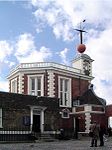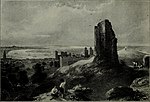Greenwich

Greenwich ( (listen) GREN-itch, GRIN-ij, GRIN-itch, or GREN-ij) is a town in south-east London, England, located in the historic county of Kent and the ceremonial county of Greater London. It is situated 5.5 miles (8.9 km) east-southeast of Charing Cross. Greenwich is notable for its maritime history and for giving its name to the Greenwich Meridian (0° longitude) and Greenwich Mean Time. The town became the site of a royal palace, the Palace of Placentia from the 15th century, and was the birthplace of many Tudors, including Henry VIII and Elizabeth I. The palace fell into disrepair during the English Civil War and was demolished to be replaced by the Royal Naval Hospital for Sailors, designed by Sir Christopher Wren and his assistant Nicholas Hawksmoor. These buildings became the Royal Naval College in 1873, and they remained a military education establishment until 1998 when they passed into the hands of the Greenwich Foundation. The historic rooms within these buildings remain open to the public; other buildings are used by University of Greenwich and Trinity Laban Conservatoire of Music and Dance. The town became a popular resort in the 18th century and many grand houses were built there, such as Vanbrugh Castle (1717) established on Maze Hill, next to the park. From the Georgian period estates of houses were constructed above the town centre. The maritime connections of Greenwich were celebrated in the 20th century, with the siting of the Cutty Sark and Gipsy Moth IV next to the river front, and the National Maritime Museum in the former buildings of the Royal Hospital School in 1934. Historically an ancient parish in the Blackheath Hundred of Kent, the town formed part of the growing conurbation of London in the 19th century. When the County of London, an administrative area designed to replace the Metropolitan Board of Works, was formed in 1889, the parish merged with those of Charlton-next-Woolwich, Deptford St Nicholas and Kidbrooke to create the Metropolitan Borough of Greenwich. When local government in London was again reformed in 1965, it merged with most of the Metropolitan Borough of Woolwich, creating what is now the Royal Borough of Greenwich, a local authority district of Greater London.
Excerpt from the Wikipedia article Greenwich (License: CC BY-SA 3.0, Authors, Images).Greenwich
Duke Humphrey Road, London
Geographical coordinates (GPS) Address Website Nearby Places Show on map
Geographical coordinates (GPS)
| Latitude | Longitude |
|---|---|
| N 51.48 ° | E 0 ° |
Address
Greenwich Park
Duke Humphrey Road
SE10 8QY London (Royal Borough of Greenwich)
England, United Kingdom
Open on Google Maps









